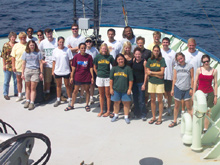Opportunities and Experiences
July 31, 2003
Dr. Carolyn Ruppel, Co-Chief Scientist
Associate Professor
Georgia Institute of Technology
Catalina Martinez, Mission Coordinator
NOAA Office of Ocean Exploration
The 20 science party members for Windows to the Deep expedition include 16 participants who are either currently seeking or recently finished graduate or undergraduate degrees. Oceanographic cruises often include numerous Ph.D.-level researchers and university professors with a few of their own graduate students along to help with data acquisition and analysis, scientific watches, laboratory analyses, and instrument deployment and recovery.
In keeping with the outreach emphasis of NOAA’s Ocean Exploration program, co-Chief Scientists Dr. Carolyn Ruppel and Dr. Cindy Van Dover assembled a science party that included only one other Ph.D. researcher, collaborating scientist Dr. Steve Holbrook. The student members of the science party include current undergraduates from The College of William and Mary (biology), Savannah State University (marine science), and Massachusetts Institute of Technology (chemistry), and recent graduates of Georgia Tech, Brown University (geology), and University of Illinois (geology). Four of the William and Mary graduate students are seeking or have just finished Master’s degrees with co-Chief Scientists Dr. Van Dover, and five other members of the science party are completing Ph.Ds in biology, oceanography, chemistry, and geophysics at Georgia Tech, the University of Virginia, and the University of Wyoming.
With seven Alvin dives scheduled during the expedition, the co-Chief Scientists planned to give as many students as possible the rare opportunity to visit the seafloor. Eleven of the junior members of the science party dove in Alvin, and for nine of these students, this marked their initiation into exploration of the deep sea with the Alvin submersible. The experiences of these students, who will go on to pursue careers in science and other fields, will have an impact far beyond The Windows to the Deep expedition and the students’ own universities.
Dive 3913
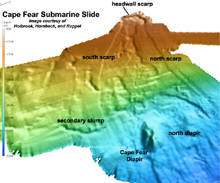
This new map of the Cape Fear slide is the most complete and highest quality ever produced. Click image for larger view.
As they continued their search for the elusive methane seeps, the researchers decided to attempt two more dives on features related to the Cape Fear submarine slide and Cape Fear Diapir. In contrast to some other submarine slides that are spatially associated with gas hydrates, the Cape Fear slide still appears to have significant gas present at depth. Faults and other high permeability conduits that tap into this gas might feed surface seeps, particularly in areas where thermal or chemical gradients enhance flow.
The nighttime program of subbottom profiling was used to identify the target for the first-ever dive to this huge slide scar.The landing spot was in a rubble field containing debris from the Cape Fear slide. The original dive plan called for Alvin to conduct a survey that crossed the transition from this material to an anomalous area that looked like a gas-charged bathymetric high bordered by a fault scarp.
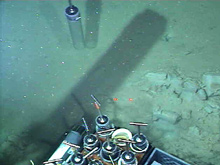
A push core being inserted into the thick muddy sediment at 2156 m during dive 3913. Photo courtesy of WHOI. Click image for larger view.
Many large submarine slides on Earth’s continental margins may be related to destabilization of gas hydrate-bearing sediments resulting from climate change (e.g., changes in bottom water temperature), earthquakes, or other perturbations. Not surprisingly, a significant component of active gas hydrate research focuses on potential geohazards related to natural or human-induced (e.g., drilling) triggers. The Ocean Exploration log for Alvin Dive 3911 describes the formation of the Cape Fear slide and its relationship to the Cape Fear Diapir.
Within the next month, Dr. Steven Holbrook, a collaborating scientist on The Windows to the Deep expedition and a professor at the University of Wyoming, will begin a month-long National Science Foundation-sponsored program to acquire high-resolution seismic data across the Storegga slide, the largest submarine slide on Earth. The Storegga slide, which lies on the Norwegian margin, occurred about 8,000 years ago, and the tsunami associated with the slide inundated the Scottish coast to a depth of about 1 meter. Like the older Cape Fear slide, the Storegga slide has long been interpreted as a slope failure resulting from destabilization of free gas and gas hydrate in the shallow marine sediments.
Alvin Dive 3913 was led by Pat Hickey, the Alvin Expedition Leader for the cruise and a pilot with over 500 dives under his belt. He was accompanied by pilot-in-training (PIT) Mark Spear and Georgia Tech Ph.D. student Alex Rao, who is conducting chemical oceanography research under the direction of Dr. Richard Jahnke of the Skidaway Institute of Oceanography. Alex has previously sailed on numerous coastal research cruises, but has never before been aboard a large oceangoing vessel like the R/V Atlantis or visited the ocean floor. Her current research on permeable sands of the continental shelf in the South Atlantic Bight is not directly related to The Windows to the Deep expedition. However, she has been a dedicated member of the ‘all-nighter’ push core team running the beloved squeezer.
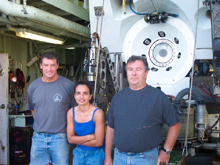
(From left to right) Alvin pilot in training, Mark Spear, Georgia Tech graduate student Alex Rao, and Alvin expedition leader, Pat Hickey with the Alvin. Photo courtesy of M. Olsen. Click image for larger view.
Alex Rao described her dive experience as "frightening for about the first ten minutes, but then [she] enjoyed the darkness and the 1.5 hour journey to the seafloor." The pilots guided the submersible to about 2100 m depth to survey another targeted region of the Cape Fear slide and escarpment. Listening to Pat and Mark run through several training sequences in the dark, Alex was able to relax and enjoy the ride. Once on the bottom, Alex was impressed with how the pilots ‘hovered’ about one meter above the muddy bottom during their survey. The dive site proved to be very unusual with steep drop-offs and vertical walls of mud. "It wasn’t easy, as we lost the bottom several times!" exclaimed Alex over dinner with several other cruise participants.
Several hours into this exploratory dive, a satellite phone call was successfully transmitted to the sub from 25 teachers from South Carolina, participating in a Professional Development Institute with Office of Ocean Exploration National Education Coordinator, Paula Keener-Chavis.
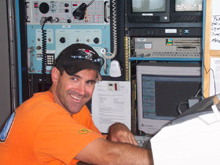
Alvin pilot Bruce Strickrott in the top lab during the satellite phone call transmission to Alvin. Click image for larger view.
From the Alvin top lab, pilot Bruce Strickrott assisted Catalina Martinez, with the transmission of questions from Paula and the teachers down to Alvin. Teachers were curious about Alex’s first dive experience, as well as Mark’s training to become an Alvin pilot. Alex described her initial trepidation, and sounded excited when asked to describe what she had seen during her dive.
"Mostly I’ve seen a very muddy bottom, but there have been lots of brittle stars, seastars, various fishes, corals, sponges, and even an octopus!" Alex also said that as they surveyed the region, there were several very steep drop-offs, and they encountered a few vertical walls of mud.
This was Mark’s fourth PIT dive, and he explained that it could take up to two years to become a full-fledged Alvin pilot. He told the teachers that the training was extensive and is specific to each submersible. The satellite transmission went very well, and as a final question, the teachers wanted to know what the three of them had for lunch in the sub. Pat said that they had peanut butter and jelly sandwiches while at about 2000 m, looking at their muddy surroundings!
Later that evening, once the sub and its passengers were safely back on deck, Pat elaborated on the question from the teachers regarding the extensive nature of Alvin pilot training. “It’s not about bottom-time,” explained Pat. He told us that the length of time it takes for a person to become a certified Alvin pilot really depends on the individual. They need to learn every nuance involved with actually piloting Alvin and collecting samples with Alvin’s manipulators. They also need to understand how the sub works, and how to fix and maintain its mechanical and electrical systems.
"Before you can become an Alvin pilot you have to sit for science board exams, engineering board exams, an intense pilot peer review, as well as Navy board certified exams," said Pat. This veteran Alvin pilot made it clear that becoming certified as a pilot was extremely difficult. This may explain in part why so few complete this rigorous program.
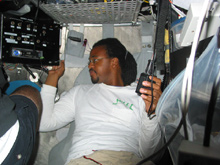
Savannah State University undergraduate, John Braxton during his first Alvin dive. Click image for larger view.
My first Alvin dive: What a wonderful experience!
John Braxton
Undergraduate Student Savannah State University
Usually people have no idea what kind of mood I am in, or how I am feeling. However, when I found out that I would be an observer on Alvin dive 3912, everyone on the ship could see a bright smile of excitement and anticipation on my face.
The night before the dive I got very little sleep. Even though my alarm was already set, I woke up every few hours to see if it was time to get ready. Never in my entire life have I been so happy to hear my alarm go off. I was on the deck a half-hour before the launch, with people watching me pace the deck with nervous energy. As I was trying to work my six-foot-three inch, 235-pound frame into the small round door atop the sub I though to myself, “ I am going to the bottom of the Atlantic Ocean today.”
As we sat in the sub waiting for the launch, there were two things that scared me. First, a storm rolled in that could have cancelled our dive, and then we heard on the radio that there was a problem with the A-frame crane that deploys and recovers the sub. After about 15 minutes of being nearly breathless, we got the OK to dive. As we began to dive, I could see clear blue water from my porthole view. By the time we were 230 m from the surface, the sunlight was very dim and we began to see bioluminescent organisms. At one point, the sub pilot flashed the strobe light through the water and the water around us lit up as if we were inside a huge jar filled with fireflies. When we reached about 370 m, it was pitch black outside the sub.
After descending for about 1 hour, the pilot turned the outside lights on and it appeared as if the sea floor was racing toward us. When we finally reached the bottom, I was amazed at what I saw. Just outside my porthole at 2,170 m below the surface of the ocean, there was a light pink sea star. The bottom was tan and very flat where we landed. As we began to move around I saw more sea stars and some small crabs, but other than that there was very little life around. As we approached the first sample collection site, there was more life around. Most of the organisms were clams and mussels, which were growing in large scattered patches on the sea floor. We also saw free-swimming dark red shrimp and some lighter ice shrimp that stayed grouped together inside holes on the side of a mound of gas hydrate. We saw 15–20 fish that were dark in color and were swimming alone just above the sea floor.
The most exciting thing I saw was an octopus that cautiously watched us as we moved along the bottom. After we collected all of our samples and began our way back to the surface, I thought about how far I was from the street in west Baltimore were I grew up, and how lucky I was to have this experience. This dive proved to be one of the most exciting days of my life and an experience that I will never forget!



















